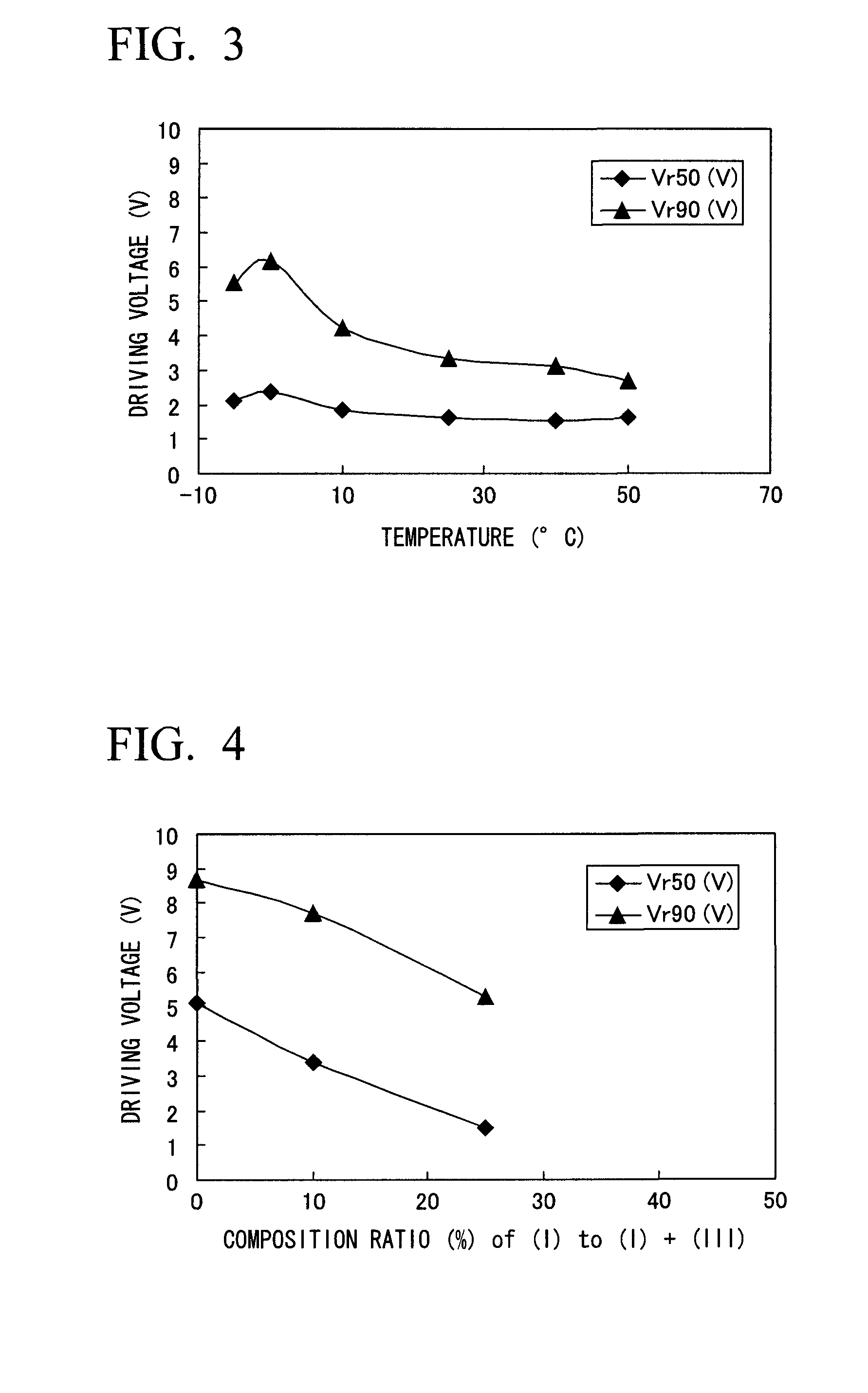Polymer-stabilized liquid crystal composition, liquid crystal display device, method for producing liquid crystal display device
- Summary
- Abstract
- Description
- Claims
- Application Information
AI Technical Summary
Benefits of technology
Problems solved by technology
Method used
Image
Examples
example 1
[0380]A polymer-stabilized liquid crystal composition was prepared by mixing 94% of a liquid crystal composition FLC-1, 5.4% of a compound (III-AA) and 0.6% of a compound (I-1), and a liquid crystal display device was produced by polymerize an acrylate compound in the polymer-stabilized liquid crystal composition by the above method for producing a polymer-stabilized liquid crystal display device. An applied voltage Vr50 at a transmittance of 50% and an applied voltage Vr90 at a transmittance of 90% were measured at a temperature within a range from −5 to 50° C. The results are shown in Table 2.
TABLE 2(Example 1)Temperature (° C.)Vr50 (V)Vr90 (V)−53.066.60 02.996.67102.676.67252.756.77502.486.75ΔV0.58−0.15ΔV is Vr (−5° C.) − Vr (50° C.)
[0381]As is apparent from a comparison between Table 1 and Table 2, the polymer-stabilized liquid crystal composition, which does not contain a compound of the formula (I-1) as a compound represented by the general formula (I-a), of Comparative Exampl...
example 2
[0382]A polymer-stabilized liquid crystal composition was prepared by mixing 97% of a liquid crystal composition FLC-1, 0.49% of a compound (III-AA), 2.205% of a compound (I-1) and 0.305% of Irgacure 651 (Irg651), and a liquid crystal display device was produced by polymerize an acrylate compound in the polymer-stabilized liquid crystal composition by the above method for producing a polymer-stabilized liquid crystal display device. An applied voltage Vr50 at a transmittance of 50% and an applied voltage Vr90 at a transmittance of 90% were measured at a temperature within a range from −5 to 50° C. The results are shown in Table 3.
TABLE 3(Example 2)Temperature (° C.)Vr50 (V)Vr90 (V)−52.115.54 02.366.16101.834.25251.653.35401.533.13501.622.70ΔV0.492.84ΔV is Vr (−5° C.) − Vr (50° C.)
[0383]As is apparent from a comparison between Table 1 and Table 3, the polymer-stabilized liquid crystal composition containing a compound of the formula (I-1) as a compound represented by the general form...
example 3
[0384]A polymer-stabilized liquid crystal composition was prepared by mixing 94% of a liquid crystal composition FLC-1, 4.41% of a compound (III-AA), 1.47% of a compound (I-1) and 0.12% of Irgacure 651 (Irg651), and a liquid crystal display device was produced by polymerize an acrylate compound in the polymer-stabilized liquid crystal composition by the above method for producing a polymer-stabilized liquid crystal display device. An applied voltage Vr50 at a transmittance of 50% and an applied voltage Vr90 at a transmittance of 90% were measured at room temperature. As a result, Vr50 was 1.5 V and Vr90 was 5.3 V.
PUM
| Property | Measurement | Unit |
|---|---|---|
| Temperature | aaaaa | aaaaa |
| Temperature | aaaaa | aaaaa |
| Fraction | aaaaa | aaaaa |
Abstract
Description
Claims
Application Information
 Login to View More
Login to View More - R&D
- Intellectual Property
- Life Sciences
- Materials
- Tech Scout
- Unparalleled Data Quality
- Higher Quality Content
- 60% Fewer Hallucinations
Browse by: Latest US Patents, China's latest patents, Technical Efficacy Thesaurus, Application Domain, Technology Topic, Popular Technical Reports.
© 2025 PatSnap. All rights reserved.Legal|Privacy policy|Modern Slavery Act Transparency Statement|Sitemap|About US| Contact US: help@patsnap.com



